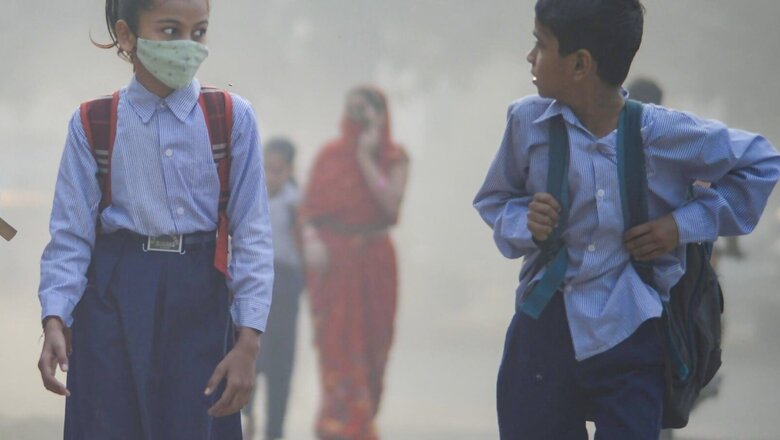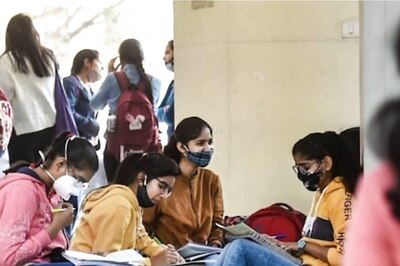
views
Even as the air quality continues to remain ‘very poor’ across Delhi, latest data shows the national capital has just recorded its lowest-ever daily average values of PM10 and PM2.5 in 2022. This excludes 2020 when pandemic-induced lockdown brought a sudden fall in pollution levels.
According to the data shared by the Commission for Air Quality Management in NCR and Adjoining Areas (CAQM), the recorded daily average values for two of the most dangerous particulate matter in air – PM10 and PM2.5 were even lower than 2021 when there were still some restrictions due to pandemic.
Not only has there been a reduction in the number of days with ‘severe’ AQI from 20 in 2022 to just 6 this year, Delhi in 2022 also saw no ‘severe +’ day when AQI shoots up to 450. While this may indicate the success of various preventive and mitigative field actions put into place, the astonishing drop in AQI has piqued scientists’ interest who are now investigating the same.
“While there is no denying that control measures must have worked, but we should not overlook the fact that 2022 saw some unprecedented and unusual natural conditions, that had not occurred in the previous years,” Dr Gufran Beig, Founder Project Director of India’s first air quality forecasting system SAFAR at IITM-Pune tells News18.
Rare Triple-dip La Nina and Change in Winds
The senior scientist is referring to the ‘rare triple-dip La Nina’. A naturally occurring ocean phenomenon, La Nina, is characterised by cooling of the surface waters over the equatorial Pacific Ocean. While it occurs after every two to seven years, it does not stay for as long as it did this time — three consecutive years (2020-2022), and therefore, rare.
“It is quite unusual for La Nina to continue so long. Whether it’s because of climate change, we do not know. But La Nina is known to disturb the overall wind circulation pattern, so it definitely had a role to play, and we are investigating that,” says Beig who is now Chair Professor at National Institute of Advanced Studies (NIAS) at IISc, Bangalore. “There was a change in not only the speed, but direction of winds.”
Meteorologists say the surface wind speeds were slightly higher for most time of the year in Delhi, which helped in dispersing the pollutants faster. Not just Delhi, but several other north-western cities also saw an improvement in air quality this winter. “The winds were northerly for a considerable period of time. These are relatively cleaner, unlike the north-westerly winds that carry dust and smoke from Punjab, Haryana,” adds Beig.
Delayed Winter Onset
Not just the winds, the temperatures were normal to above-normal for most days of the year. The winter onset was delayed, and the weather was unusually warm from October till mid-December. Unlike the cold air that traps more pollutants, and holds them much longer, warm air tends to move slightly faster.
No wonder, Delhi in 2022 also saw the cleanest air the morning after the festival despite all firecrackers. Similar conditions continued till mid-December with clear skies and sunny days, which explain why December recorded the lowest-ever AQI of 306 (average) in the last six years, even better than 332 in December of 2020. A stark improvement was seen for most part of the post monsoon season from October to December.
Another critical factor that has piqued the interest of scientists is the significant lack of western disturbances (that bring rain) over north-western plains. “There were no major active WDs in November or December, which would have brought chill to the Indo-Gangetic plains. This was unusual. But we are yet to analyse its overall role,” he adds.
Some Improvement, Nonetheless
While the sudden fall in PM10 and PM2.5 levels in 2022 is surprising, Delhi has been recording some improvement in air quality since 2015, agree air quality experts. The data maintained by the India Meteorological Department (IMD) shows how the daily average PM10 values were recorded to be 211 and PM2.5 at 98 for 2022, which were better than 2021 when there were still some restrictions on activities due to the pandemic.
The daily average of AQI during the first three months from January to March was even better than low activity years of 2020 and 2021. Overall the national capital saw 225 days of moderate to poor AQI (101-300), with 68 days with ‘good’ and ‘satisfactory’ AQI, and 72 days when the AQI went above 300 plunging to very poor levels. As per date, PM2.5 levels in Delhi were in ‘severe’ category for 204 hours, which was much less than 628 hours in 2021.
Meanwhile, CAQM is confident that air quality scenario over Delhi would see further gradual but marked improvement, year-on-year with persistent field level efforts and targeted policy initiatives in the long run.
Read all the Latest India News here



















Comments
0 comment